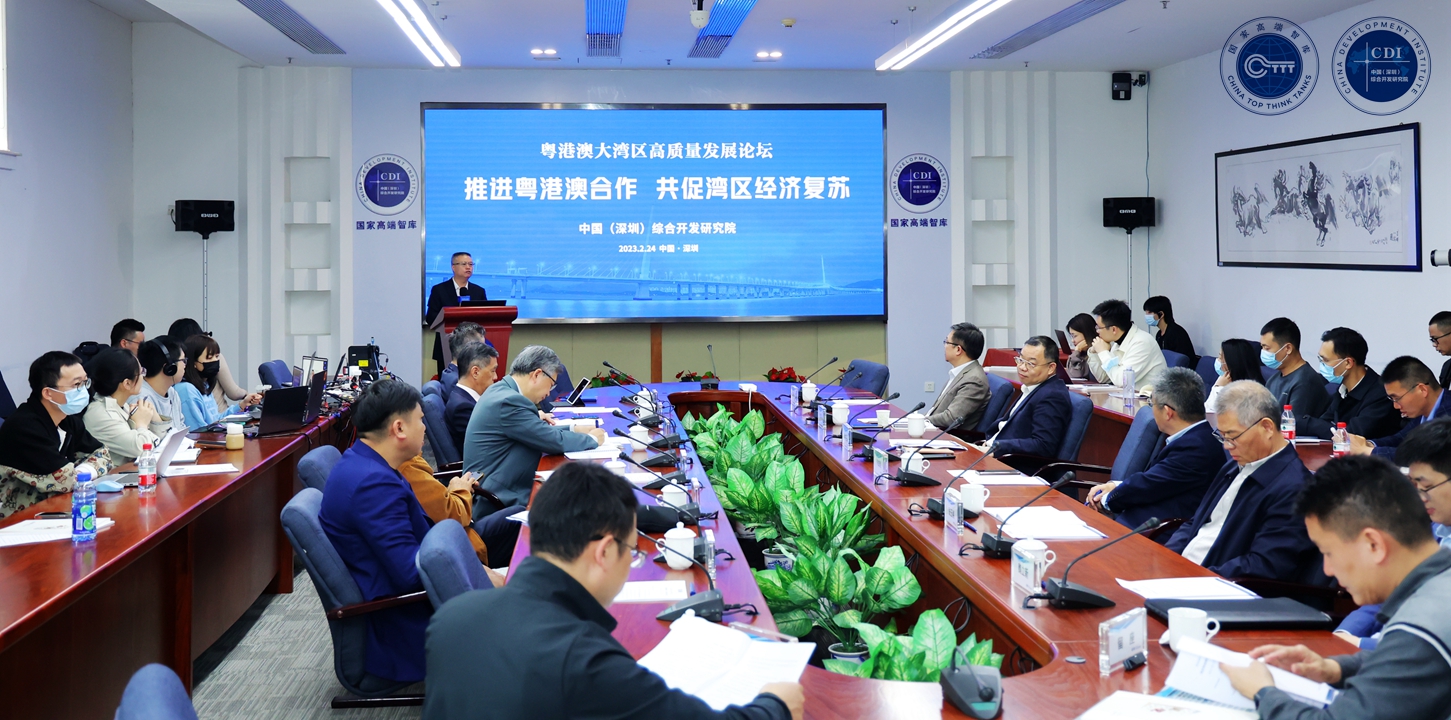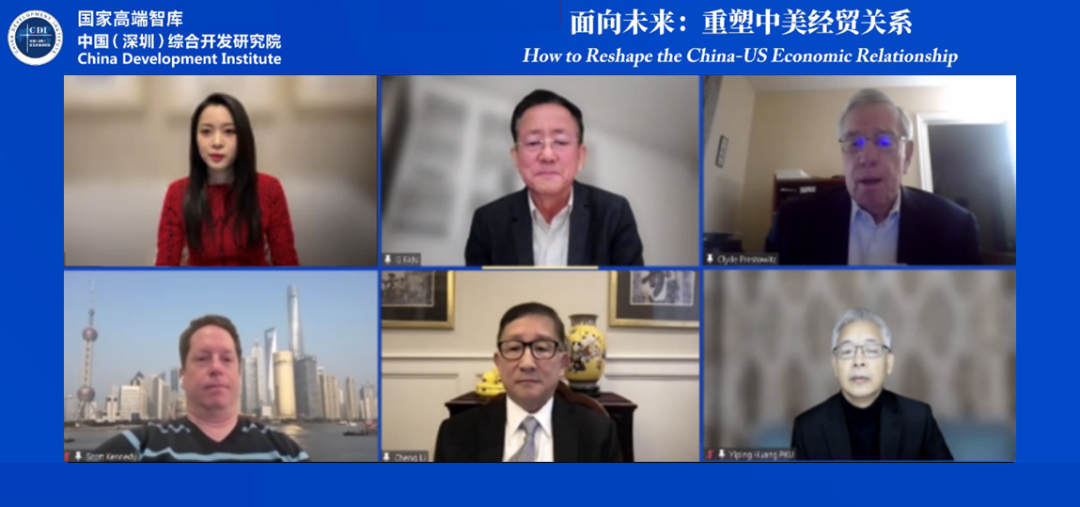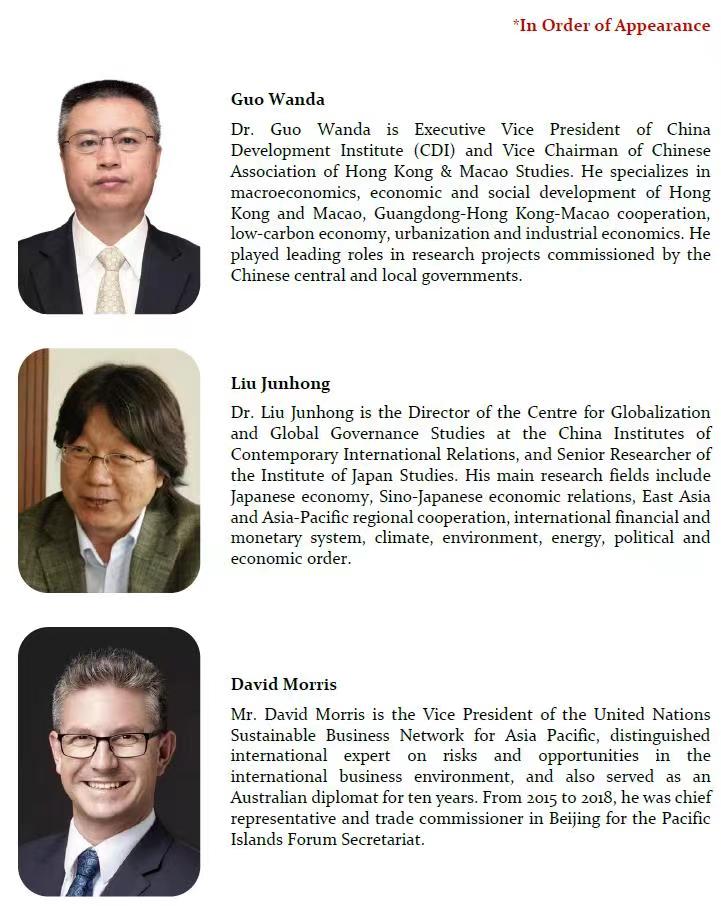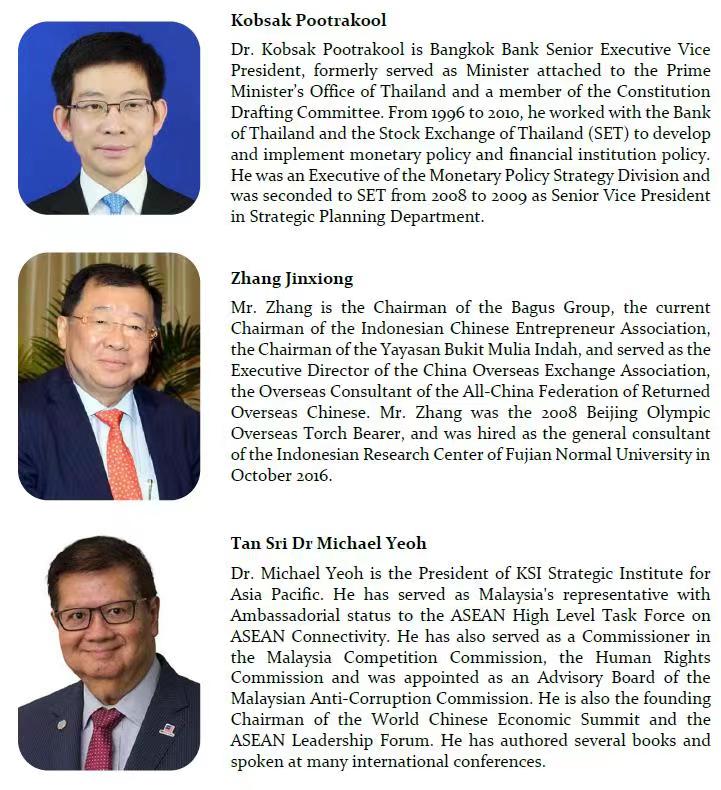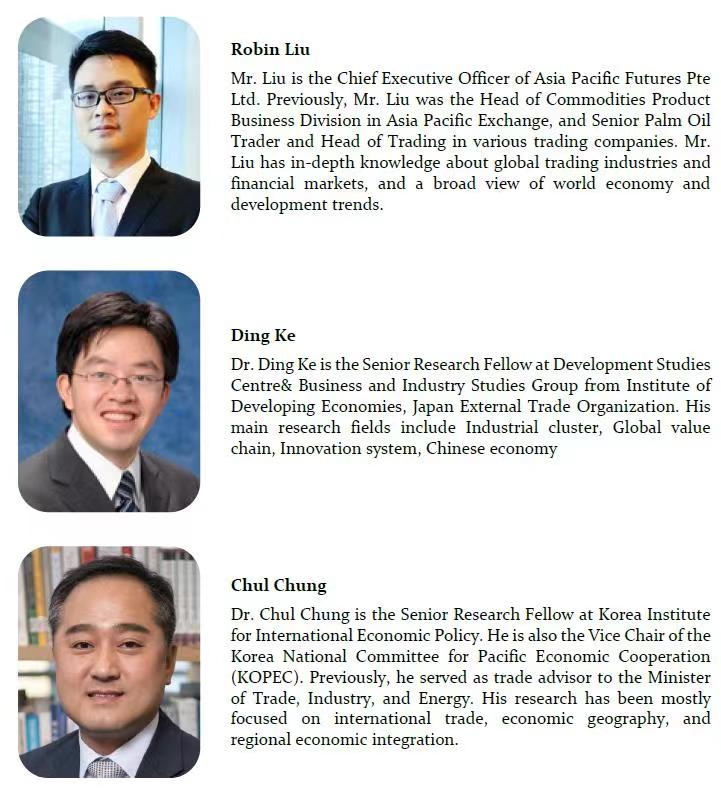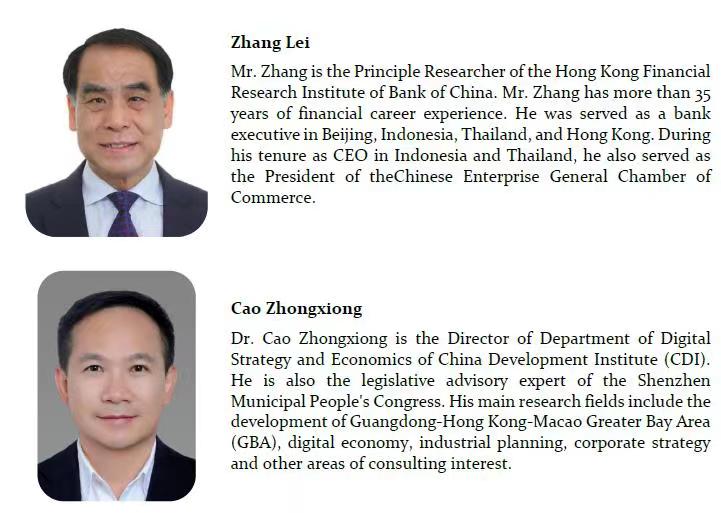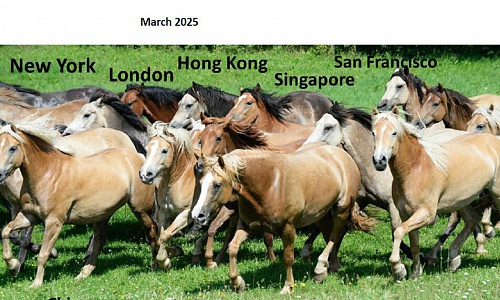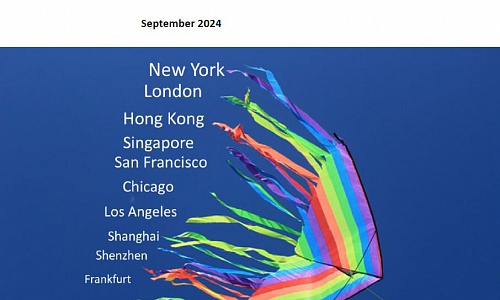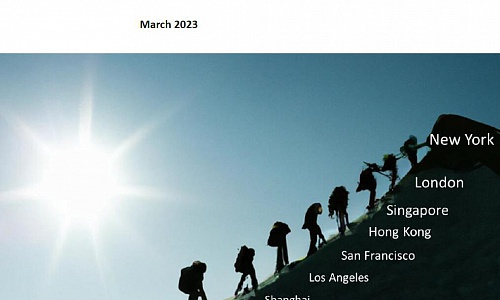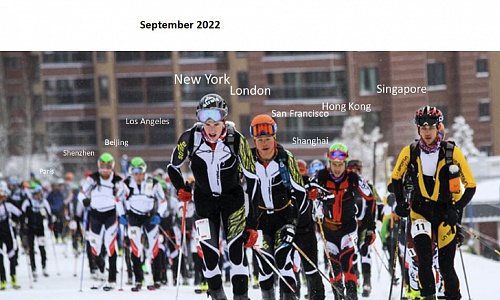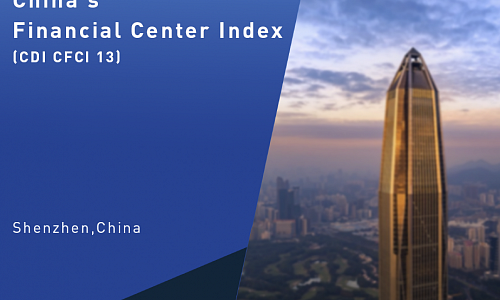New Zealand China Council Visits CDI
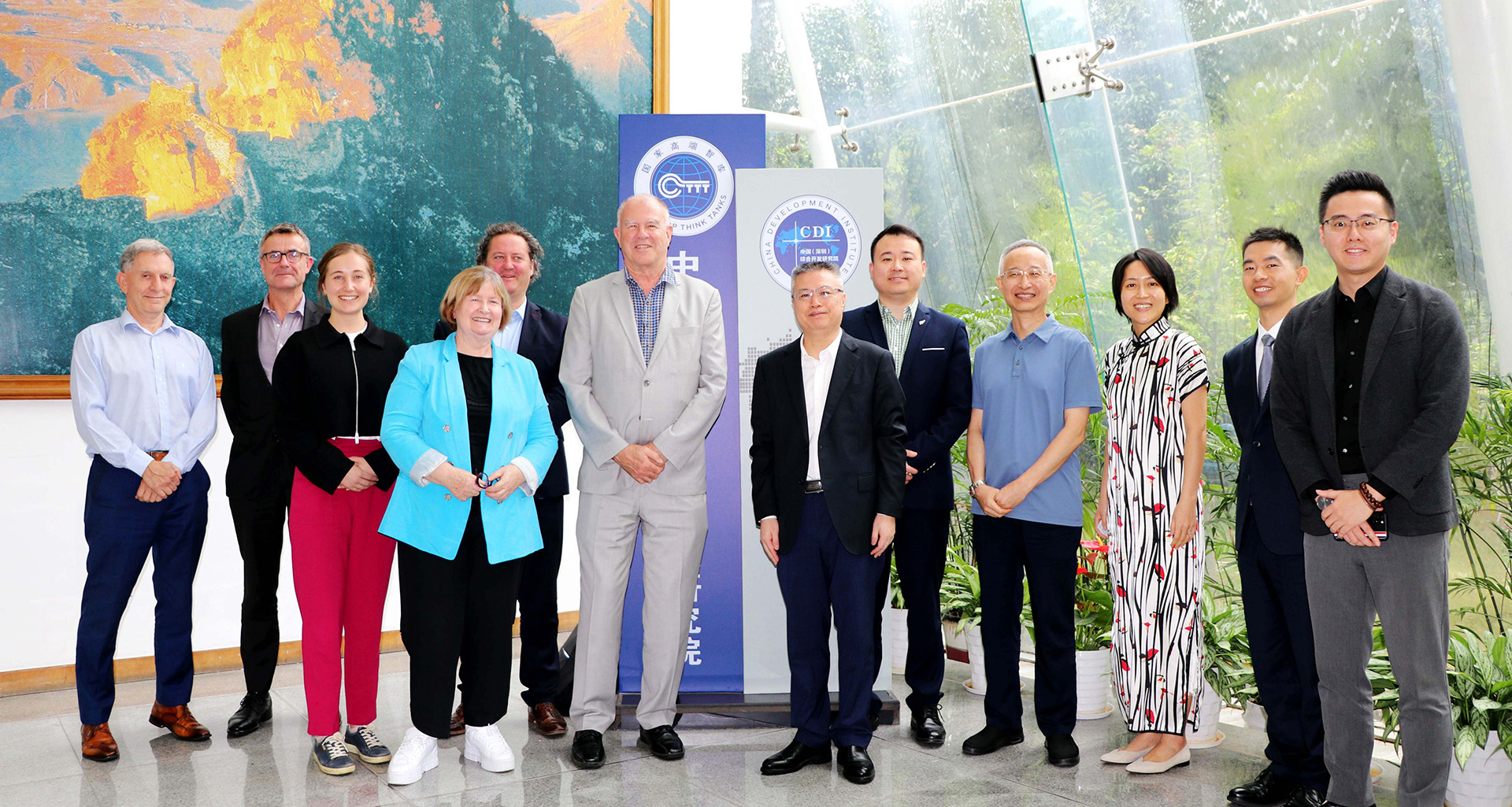
The New Zealand China Council delegation led by Mr. John McKinnon visited China on May 12, 2023. Dr. Guo Wanda, Executive Vice President of CDI, introduced the current trends of Guangdong-Hong Kong-Macao Greater Bay Area, as well as Shenzhen’s role in the GBA development. Experts from New Zealand provided updates and insights on CPTPP and DEPA, as well as China’s prospect in joining CPTPP. The two parties also exchanged experience and views on how to balance environmental management and economic development.
China-ASEAN Think Tanks Webinar - How to Revitalize the Regional Economic Connectivity in the Post-Pandemic Era
Information
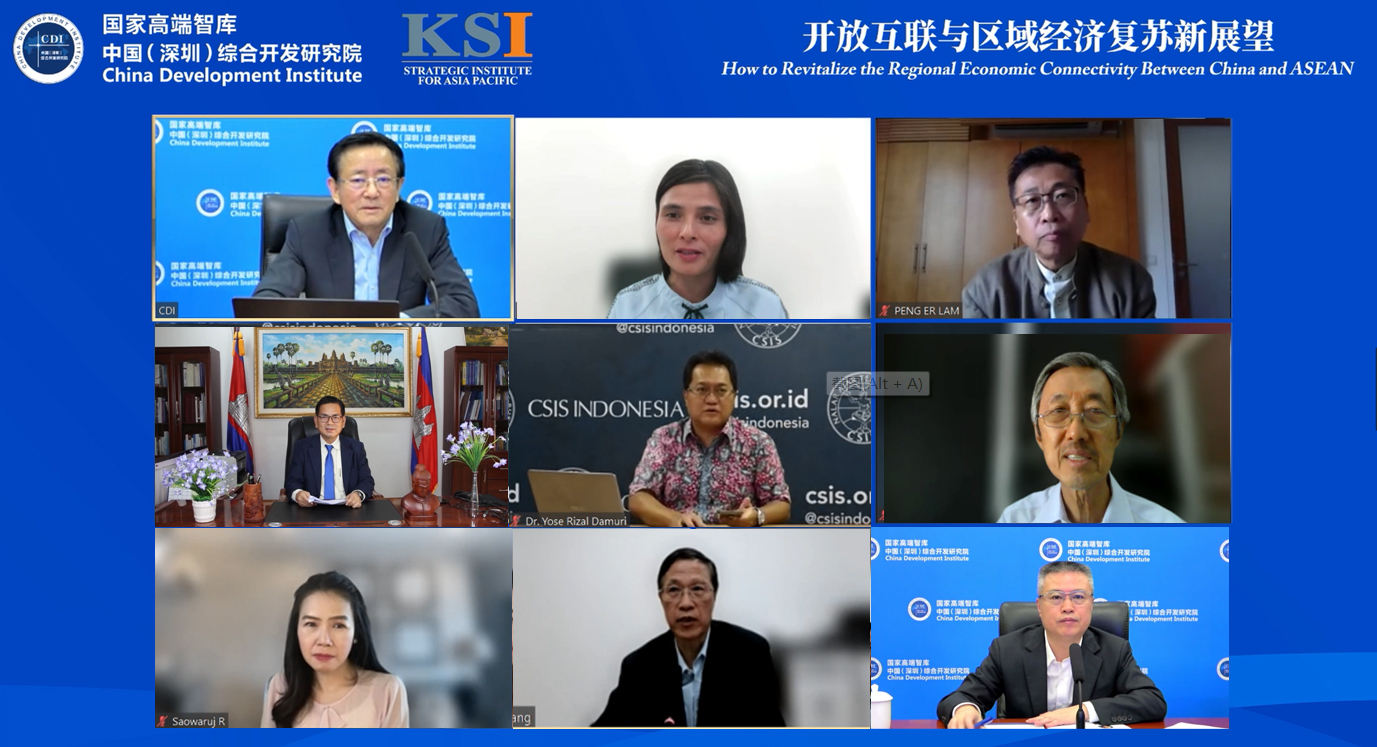
Information
In November 2022, at the 25th ASEAN-China Summit held in Phnom Penh, the two sides announced ASEAN-China Joint Statement on Strengthening Common and Sustainable Development, emphasizing the effective synergy between statements and visions put forward by ASEAN and China will be conducive to realizing the Sustainable Development Goals(SDGs) in the region and beyond. A new chapter of bilateral partnership is expected to unleashed, heading toward high-standard cooperation.
Since the establishment of ASEAN-China Dialogue Relations in 1991, cooperative relations between both sides have been tested and deepened. Driven by free trade mechanisms such as the upgraded China-ASEAN FTA and the RCEP, the trade volume between both sides has grown rapidly. In 2022, China remained ASEAN's largest trading partner for the 13th consecutive year, while ASEAN became China's largest trading partner. Even so, trade frictions and geopolitical crises in recent years had increased future economic uncertainties. With the international economic situation keeps changing, China and ASEAN cannot be isolated from the outside world. How can China and ASEAN make joint effort to boost the economic recovery in the face of major challenges is worth addressing.
Against such background, the webinar hosted by China Development Institute (CDI) and KSI Strategic Institute for Asia Pacific (KSI) will provide a platform for exchanges on the cooperation and challenges we are facing. This event has lasted for several years and we are grateful to those participating think tanks for their contribution of knowledge and wisdom.
Debates
- Facing growing geopolitical competitions and protectionism in the post-pandemic era, how can China better integrate to the regional economic cooperation with ASEAN?
- What challenges and risks still remain when it comes to synergizing the Belt and Road Initiative and Master Plan on ASEAN Connectivity 2025 in jointly enhancing connectivity and stability of regional supply chain, and how should they be addressed properly?
- What could be done in the region to promote cooperation with the opportunity of the Fourth Industrial Revolution and digital transformation to achieve green industrialization and sustainable growth?
Consulate General of Australia in Guangzhou Delegation Visited CDI
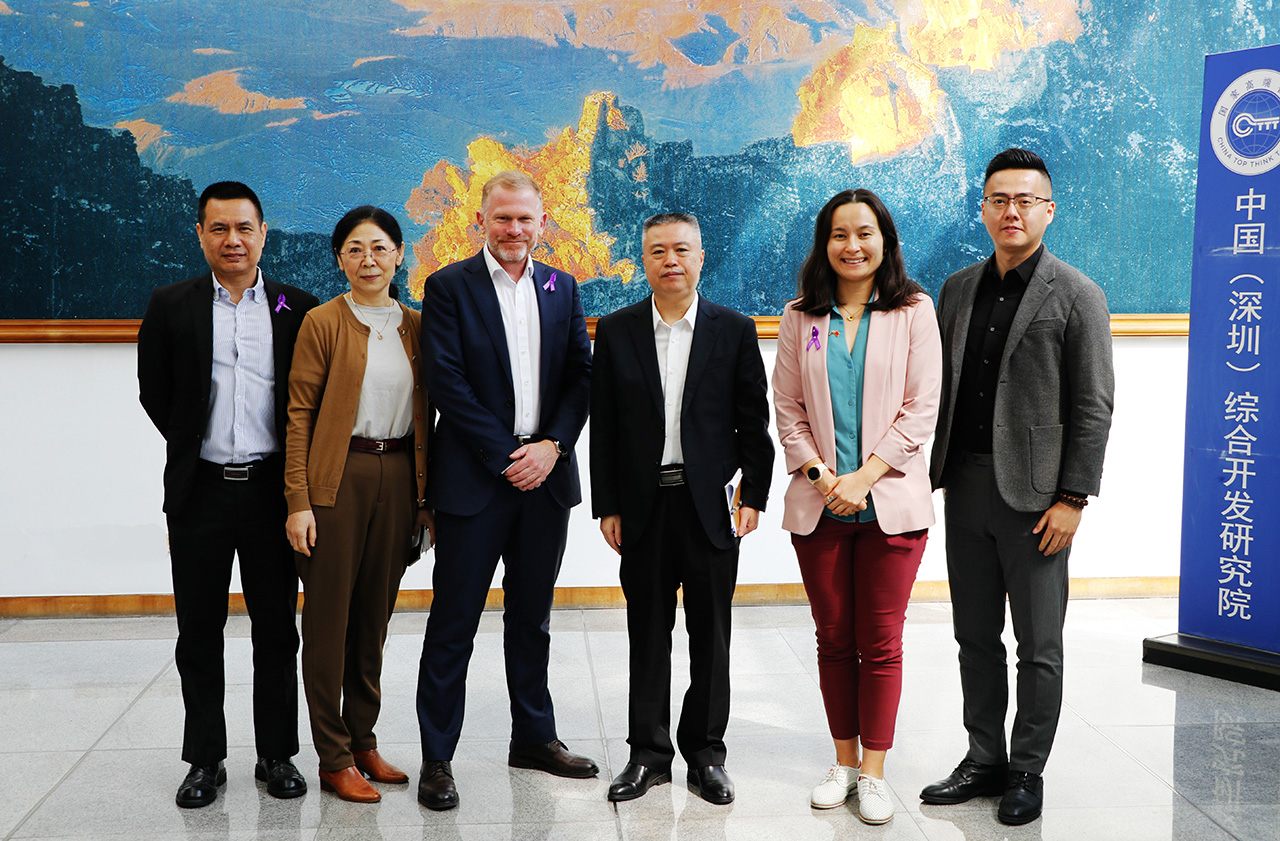
Delegation led by Australian Consul-General in Guangzhou Mr. Anthony Aspden visited CDI on Wednesday March 8, 2023. Both sides exchanged views on the latest trend of China's development. Dr. Guo Wanda, Executive Vice President of CDI, provided an overview of the recent economic developments in China, specifically in the Guangdong-Hong Kong-Macao Greater Bay Area (GBA). China will continue to expand institutional opening-up and follow the dual circulation development model. As China turned the page on Covid-19 pandemic, China’s GDP growth rate is expected to be 5% in 2023.
University of British Columbia Professor Jamie Peck Visited CDI

On Feb 24, 2023, Professor Jamie Peck of University of British Columbia, Canada visited CDI. CDI experts introduced the structure and recent developments of the Guangdong-Hong Kong-Macao Greater Bay Area (GBA). Afterwards, the two parties exchanged views on the GBA, particularly the coordination mechanism with respect to policy making and implementation. Both parties agreed that with three different legal systems, three different customs regimes and three different currencies, the GBA is distinct from the other world-renowned bay areas and faces a unique set of both opportunities and challenges. As a result, the governments are expected to explore and dynamically adjust the implementation pathway of GBA framework.
Guangdong-Hong Kong-Macao Greater Bay Area High Quality Development Forum
Information

Information
On February 6, 2023, Chinese mainland and Hong Kong border fully reopened. The full resumption of flow of people at the Shenzhen-Hong Kong ports will greatly facilitate the interconnection between Hong Kong, Macao and mainland cities, stimulating the demand for tourism, shopping, business, and investment, etc., accelerating the integration of technology, capital and other resources, and contributing to the economic development of the Guangdong-Hong Kong-Macao Greater Bay Area (GBA).
In the face of new challenges in the global economy, the GBA development should be oriented towards more open cooperation. Therefore, in the future, how to further strengthen the GBA cooperation mechanism, promote economic and trade exchanges, and strengthen high-level cooperation between GBA cities is crucial.
In this forum, organized by the China Development Institute, experts from the GBA were gathered together to discuss how Guangdong, Hong Kong and Macao should deepen regional connectivity, and expand dialogues in terms of coordinated industrial development and integrated social development.
Date and time: Friday Feb 24, 2023
Host: China Development Institute
Treat Recovery Data with Caution

Date: Feb 27, 2023
Because of Chinese New Year, the statistics bureau didn’t announce price, financial and PMI data until February. China switched from zero-COVID lockdown to almost no restrictions in December 2022, and by January 2023, normal life had nearly returned. The economy is generally improving, but caution about its sustainability is required.
Manufacturing PMI, the non-manufacturing business index and the composite PMI production index were 50.1%, 54.4%, and 52.9% in January 2023, up 3.1, 12.8, and 10.3 pps from December. All rose to the improvement zone, showing that the economy is recovering. Our in-depth analysis instead shows that the improvement is still mainly from infrastructure investment. Our survey data shows most industries and firms are only the same or in slightly better shape than in January 2022 - not a big jump from the zero-COVID policy period.
In January 2023, PPI fell -0.4% m/m, growing -0.8%, down 0.1 pps, largely because of falling oil and coal prices. CPI mildly increased. CPI rose 2.1% y/y in January, up 0.3 pps from December 2022. The rise is from demand release after pandemic control relaxation and the New Year’s holiday effect.
Monetary policy expanded. At the end of January, M1 rose 6.7% y/y, up 3 and 8.6 pps from December 2022 and January 2022, respectively. M2 rose 12.6% y/y, up 0.8 and 2.8 pps from the end of December and January 2022, reaching its peak since April 2016. The increase is due to both household deposits and enterprise loans, showing monetary policy expansion.
Chinese banks extended record lending in January, after authorities prodded them to lend more to businesses, though consumer borrowing remained subdued. In particular, financial institutions offered 4.9 trillion yuan of new loans, above the 4.2 trillion yuan estimated by economists on average, and from the earlier record of 3.98 trillion yuan a year ago. Part of the loan increase was moved from bond financing. Although this news is positive, we don’t expect economic recovery to be as strong as other analysts forecast, since consumer confidence is low.
Back on Track in 2023

Date: Jan 29, 2023
GDP grew 3% in 2022. Specifically, China’s economy rose by 2.9% y/y in Q4 2022, down from the 3.9% growth reported in Q3. Many negative factors affected the economy in 2022, including global macroeconomic tightening, the Ukraine crisis, real estate restructuring, the pandemic management policies and so forth. As some of the above factors abated, particularly abolishment of the zero-COVID policy, we expect that, after a turbulent 2022, the economy will be back on track in 2023.
Industrial output grew 3.6% in 2022, down 6 pps from 2021. Investment rose 5.1%, up 0.2 pps, driven mainly by state investment. Consumption fell significantly, by -0.2% y/y, from 2021, down 12.7 pps, from repeated lockdowns.
Exports rose 10.5%, down 10.5 pps from 2021. Exports’ monthly growth rates displayed a downward trend. Net exports’ contribution to GDP only accounted for 0.5 pps. Particularly in Q4, the share of exports in accounting for GDP growth is only -1.2 pps, negatively impacted by weak global demand and the dramatic change in domestic COVID policy.
Prices are instead facing deflation risk. In 2022, PPI rose 4.1% and CPI rose 2%. However, both displayed slowing trends. In December, PPI and CPI only grew -1.1% and 1.8% y/y. Monetary policy is still stable. M1 rose 3.7% y/y, down 0.9 pps. M2 increased 11.8% y/y, down 0.6 pps, partially reflecting weak money demand.
A series of government policies is being released to stabilize the real estate market, while discouraging speculation. On January 5th, the People’s Bank of China announced that it would allow banks in cities that experienced housing price declines to cut mortgage rates for first-time house buyers. This directive followed last month’s meeting by top national leaders, which typically gives guidance in line with the coming year’s main economic theme, and this year stated that housing consumption would be a significant way to expand national consumption. We believe the housing market will mildly strengthen this year, but not thrive. Positive factors are the abandoning of any pandemic restriction, the banking sector’s efforts to keep most real estate developers solvent and the already relatively low base number.
China-US Think Tank Webinar – How to Reshape the China-US Economic Relationship
Information
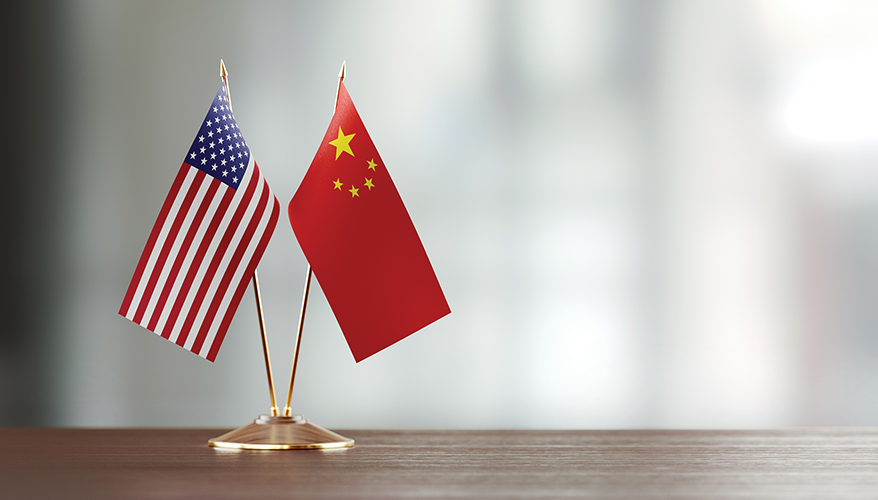
Date and time: Thursday December 15, 2022 21:00-22:40 Beijing Time
Host: China Development Institute
The world today is facing multiple challenges. As the world's two largest economies, China and the US relations are more crucial than ever for the world economy. President Xi Jinping met with President Joe Biden on November 14 in Indonesia, and the two leaders underscored the importance of establishing guiding principles for bilateral ties and hoped to push the relations back to steady.
It is noted that since China's entry into the WTO in 2001, the pragmatic trade policies had contributed to the economic prosperity of two countries and the whole world. However, in recent years, China-US trade conflict has caused the bilateral trade to decline, which has exerted negative impact on interests of both countries.
At the same time, it is necessary to recognize that there will always be issues on which the two countries have very different perspectives. In what ways can China and the US “agree to disagree” on some issues without damaging the broader relationship? Despite the differences, both countries truly benefited from their relationship and have to find ways to preserve those beneficial aspects.
In light of this situation, this webinar, organized by China Development Institute, is aimed to maintain dialogue among experts and scholars between China and the US to highlight the importance of reducing tensions between the two sides.
Focus for Debate
- What ways can the two countries engage in confidence building measure? And what steps can be taken to build trust and a sense of cooperation?
- How could the two countries cooperate to keep the stability of global industrial and supply chains, which will benefit both economies and also the world?
- How should China and the US reshape the bilateral trade and investment so as to jointly address the global economic recession?
Recovery Is Constrained By Covid, Again
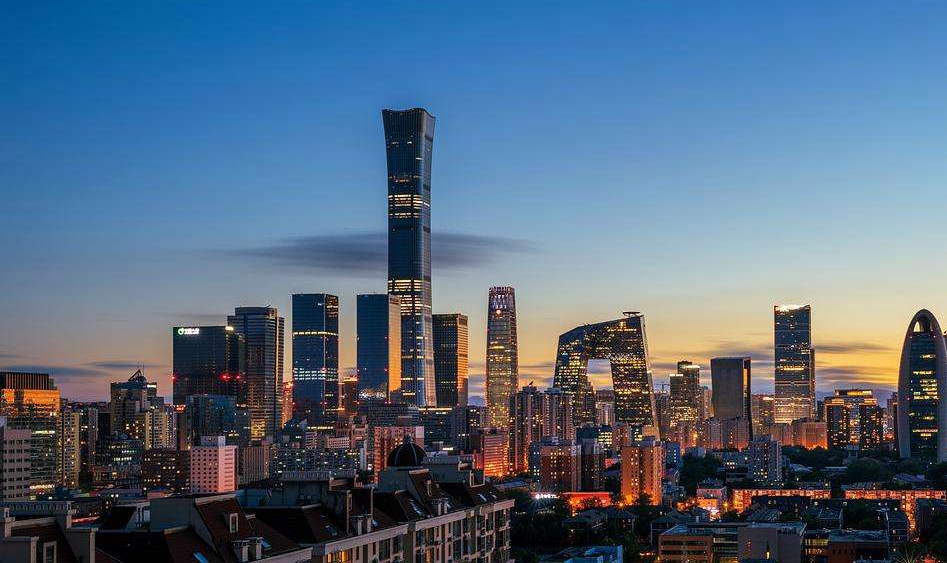
Date: Nov 24, 2022
Growth is weakly recovering, with pressure ahead largely from the Covid prevention and its related lockdowns. Although there was some rumor regarding abandoning the zero-Covid policy, there were also signs that China will commit to this policy in the short term, citing reasons from state media that China’s per capita medical resource is low. We forecast that although there might be some relaxing adjustment, for example that foreign entry has reduced to five-day quarantine from seven days, the zero-Covid policy will not be abandoned soon.
In January-October, industrial output rose 4% y/y, continuing its weak recovery since May. Investment rose 5.8% y/y, down 0.1 pps from first three quarters. China’s PMI, manufactural PMI, and non-manufactural business activity index were 49%, 49.2%, and 48.7%, down 1.9, 0.9, and 1.9 pps from September.
Retail sales of social consumption goods fell -0.5% y/y, down 3 pps from September. Exports in October rose 7% y/y, down 3.7 pps from September. The global weakening demand is the main reason behind slower exports and very likely to persist in the medium term.
Economic slowdown is driving down prices. PPI fell -1.3% y/y, down 2.2 pps from September. CPI rose 2.1% y/y, down 0.7 pps from September. The global interest rate increase to combat inflation has limited Chinese central bank’s ability to cut interest rate to support the economy. Loan demand is weak. M1 rose 5.8% y/y, down 0.6 pps. M2 rose 11.8% y/y, down 0.3 pps.
On November 11th, Beijing unveiled a 16-point plan that significantly eases a crackdown on lending to the real estate sector, leading to property developers’ share instantly increase by 11%. Key measures include allowing banks to extend maturing loans to developers, supporting property sales by reducing previous sale restrictions, boosting other funding channels, and ensuring the delivery of pre-sold homes to buyers. We believe these policies will calm the market and make real estate cooling milder, but unlikely to reverse the downward trend immediately. However, real estate collapse or systemic risk can be avoided.
Webinar on APEC: The Role of Asian Countries in Addressing Economic Recovery
Information

Date and time: Thursday November 3, 2022 14:30-17:00 (Beijing Time)
Host: China Development Institute and Hong Kong Financial Research Institute of Bank of China
Over the past 30 years, APEC cooperation has made significant progress. Since the implementation of the Bogor Goals 28 years ago, trade and investment liberalization and facilitation in the Asia-Pacific region has achieved remarkable results. Against the backdrop of risks and uncertainties in the global economy caused by the Covid-19 pandemic and supply chain disruption, the Asian region today boasts one of the most dynamic economies in the world and it has been able to enhance regional coordination and strengthen regional economic resilience under the APEC framework, while providing momentum for Asia-Pacific economic recovery.
Looking forward, the achievement of the APEC 2040 Vision requires robust dialogue, stakeholder engagement, as well as effective cooperation to reshape trust and confident relationships. In this webinar, the debate will be focused on how Asian economies could further strengthen regional trade relations and coordination through innovation and inclusiveness while achieving win-win cooperation.
Focus for Debate
- What are the new trends and opportunities for Asia-Pacific economic and trade cooperation in the post-pandemic era?
- How should the Asian economies make full use of APEC framework and jointly stabilize global industrial chain and supply chain, while supporting multilateral trading system such as WTO and empowering more countries to reap greater benefits?
- How should Asian economies explore new cooperation in areas such as digital and green development, and facilitate welcoming, transparent, impartial and market-oriented business environment for enterprises in Asia Pacific?
*Available in English and Chinese.
*For more details, please contact Mr. Kris Liu (krisliu@cdi.org.cn)
Register in advance for this webinar:
https://us06web.zoom.us/webinar/register/WN_CBRrLLJKQcaVa5l9GgNB0g
After registering, you will receive a confirmation email containing information about joining the webinar.

